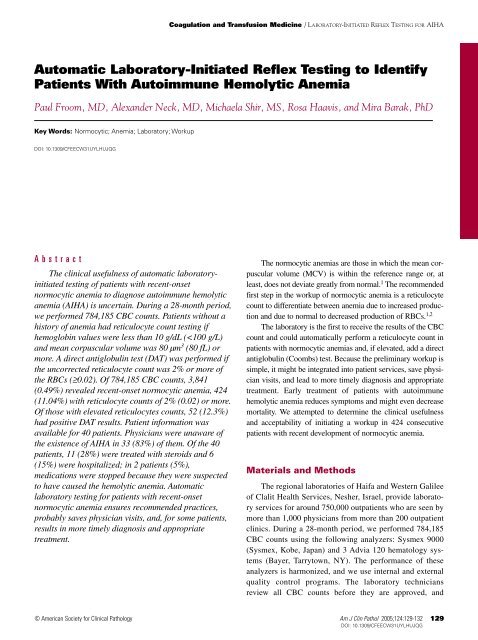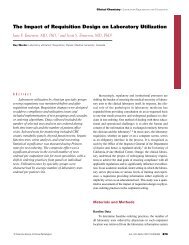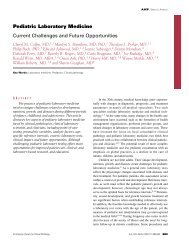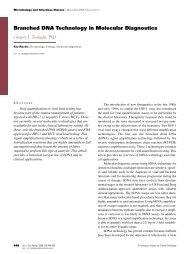Automatic Laboratory-Initiated Reflex Testing to Identify Patients ...
Automatic Laboratory-Initiated Reflex Testing to Identify Patients ...
Automatic Laboratory-Initiated Reflex Testing to Identify Patients ...
Create successful ePaper yourself
Turn your PDF publications into a flip-book with our unique Google optimized e-Paper software.
© American Society for Clinical Pathology<br />
Coagulation and Transfusion Medicine / LABORATORY-INITIATED REFLEX TESTING FOR AIHA<br />
<strong>Au<strong>to</strong>matic</strong> <strong>Labora<strong>to</strong>ry</strong>-<strong>Initiated</strong> <strong>Reflex</strong> <strong>Testing</strong> <strong>to</strong> <strong>Identify</strong><br />
<strong>Patients</strong> With Au<strong>to</strong>immune Hemolytic Anemia<br />
Paul Froom, MD, Alexander Neck, MD, Michaela Shir, MS, Rosa Haavis, and Mira Barak, PhD<br />
Key Words: Normocytic; Anemia; <strong>Labora<strong>to</strong>ry</strong>; Workup<br />
DOI: 10.1309/CFEECW31UYLHUJQG<br />
Abstract<br />
The clinical usefulness of au<strong>to</strong>matic labora<strong>to</strong>ryinitiated<br />
testing of patients with recent-onset<br />
normocytic anemia <strong>to</strong> diagnose au<strong>to</strong>immune hemolytic<br />
anemia (AIHA) is uncertain. During a 28-month period,<br />
we performed 784,185 CBC counts. <strong>Patients</strong> without a<br />
his<strong>to</strong>ry of anemia had reticulocyte count testing if<br />
hemoglobin values were less than 10 g/dL (
Froom et al / LABORATORY-INITIATED REFLEX TESTING FOR AIHA<br />
abnormal test results are compared with previous results if<br />
present in the database.<br />
In all patients without a his<strong>to</strong>ry of anemia, we performed<br />
a reticulocyte count if the hemoglobin value was less than 10<br />
g/dL (
❚Table 1❚<br />
Univariate Analysis *<br />
led <strong>to</strong> considerable savings by decreasing physician visits.<br />
Cost-effectiveness, however, can be calculated only by determining<br />
the number of additional physician follow-up visits for<br />
patients who are not tested au<strong>to</strong>matically.<br />
Negative consequences of au<strong>to</strong>matic labora<strong>to</strong>ry testing<br />
include redundant testing in approximately 20% of the<br />
patients with a positive direct antiglobulin test result, with previous<br />
positive test results in the hospital or from other areas in<br />
Israel. This might be prevented by improved computer integration<br />
of test results from other sources. Also, 87.7% of<br />
patients with elevated reticulocyte counts did not have a positive<br />
direct antiglobulin test result, and not all with a positive<br />
direct antiglobulin test result were treated. In these patients,<br />
additional test results outside the reference range could lead <strong>to</strong><br />
negative consequences, including patient anxiety. Also, the<br />
effect of the test results on subsequent testing and treatment in<br />
patients without au<strong>to</strong>immune hemolytic anemia needs <strong>to</strong> be<br />
studied because the added testing might have had positive or<br />
negative effects on patient care.<br />
We were unable <strong>to</strong> find clinical or CBC count variables<br />
that aid in limiting direct antiglobulin testing. Neither<br />
absolute reticulocyte counts nor corrected absolute reticulocyte<br />
counts were better than the more familiar uncorrected<br />
reticulocyte test.<br />
The cu<strong>to</strong>ff for the degree of anemia needed <strong>to</strong> initiate a<br />
reticulocyte count is uncertain. It is possible that patients with<br />
a hemoglobin value of 10 g/dL (100 g/L) or more also might<br />
benefit from such testing. Further studies are warranted <strong>to</strong><br />
substantiate our findings and <strong>to</strong> determine the proper cu<strong>to</strong>ff<br />
for au<strong>to</strong>matic direct antiglobulin testing.<br />
Extrapolation of our results <strong>to</strong> other settings should be<br />
done with caution. The upper end of the reference interval for<br />
reticulocytes in our labora<strong>to</strong>ry is 1.9% (0.019) but has been<br />
reported variously <strong>to</strong> be 2.7% (0.027), 3 1.8% (0.018), 3 1.6%<br />
(0.016), 4 1.25% (0.013), 5 2.16% (0.022), 6 1.79% (0.018), 6<br />
1.55% (0.016), 6 2.24% (0.022), 6 1.44% (0.014), 6 1.85%<br />
(0.019), 7 2.3% (0.023), 7 and 1.6% (0.016), 8 depending in<br />
© American Society for Clinical Pathology<br />
Coagulation and Transfusion Medicine / ORIGINAL ARTICLE<br />
Direct Antiglobulin Test Results<br />
Variable Positive (n = 52) Negative (n = 372) P<br />
Age (y) 60 ± 20 52 ± 25 .025<br />
Female 35 (67.3) 244 (65.6) .807<br />
Reticulocyte count, % of RBCs (proportion of RBCs) 6.5 ± 5.5 (0.065 ± 0.055) 4.7 ± 2.7 (0.047 ± 0.027)
Froom et al / LABORATORY-INITIATED REFLEX TESTING FOR AIHA<br />
Conclusion<br />
The labora<strong>to</strong>ry initiation of the workup ensured recommended<br />
medical practices, probably saved physician visits,<br />
and, in some patients, led <strong>to</strong> more timely diagnosis and appropriate<br />
treatment. Our findings support the use of reflex labora<strong>to</strong>ry-initiated<br />
testing in patients with normocytic anemia.<br />
Further studies are warranted <strong>to</strong> determine whether our findings<br />
can be extrapolated <strong>to</strong> other settings.<br />
From the Central <strong>Labora<strong>to</strong>ry</strong> of Haifa and Western Galilee, Clalit<br />
Health Services, Nesher, Israel.<br />
Address reprint requests <strong>to</strong> Dr Froom: Hema<strong>to</strong>logy<br />
Labora<strong>to</strong>ries, Central <strong>Labora<strong>to</strong>ry</strong> of Haifa and Western Galilee,<br />
Clalit Health Services, Nesher, Israel.<br />
References<br />
1. Normocytic normochromic anemias other than hemolytic<br />
anemias. In: Wintrobe MW, Lee GR, Boggs DR, et al, eds.<br />
Clinical Hema<strong>to</strong>logy. 8th ed. Philadelphia, PA: Lea and Febiger;<br />
1981:677-724.<br />
2. Beutler E. Production and destruction of erythrocytes. In:<br />
Beutler E, Lichtman MA, Coller BS, et al, eds. Williams<br />
Hema<strong>to</strong>logy. 6th ed. New York, NY: McGraw-Hill; 2001:356.<br />
3. Van Houte AJ, Bartels PC, Schoorl M, et al. Methodologydependent<br />
variations in reticulocyte counts using a manual<br />
and two different flow cy<strong>to</strong>metric procedures. Eur J Clin Chem<br />
Clin Biochem. 1994;32:859-863.<br />
132 Am J Clin Pathol 2005;124:129-132<br />
132 DOI: 10.1309/CFEECW31UYLHUJQG<br />
4. Nobes PR, Carter AB. Reticulocyte counting using flow<br />
cy<strong>to</strong>metry. J Clin Pathol. 1990;43:675-678.<br />
5. Kojima K, Niri M, Se<strong>to</strong>guchi K, et al. An au<strong>to</strong>mated<br />
op<strong>to</strong>electronic reticulocyte counter. Am J Clin Pathol.<br />
1989;92:57-61.<br />
6. Van den Bossche J, Devreese K, Malfait R, et al. Reference<br />
intervals for a complete blood count determined on different<br />
au<strong>to</strong>mated haema<strong>to</strong>logy analyzers: Abx Pentra 120 Retic,<br />
Coulter Gen-S, Sysmex SE 9500, Abbott Cell Dyn 4000, and<br />
Bayer Advia 120. Clin Chem Lab Med. 2002;40:69-73.<br />
7. Buttarello M, Bulian F, Venudo A, et al. <strong>Labora<strong>to</strong>ry</strong> evaluation<br />
of the Miles H.3 au<strong>to</strong>mated reticulocyte counter: a<br />
comparative study with manual reference method and Sysmex<br />
R-1000. Arch Pathol Lab Med. 1995;119:1141-1148.<br />
8. Nobes PR, Carter AB. Reticulocyte counting using flow<br />
cy<strong>to</strong>metry. J Clin Pathol. 1990;43:675-678.<br />
9. Hegde UM, Gordon-Smith EDC, Worlledge SM.<br />
Reticulocy<strong>to</strong>penia and absence of red cell au<strong>to</strong> antibodies in<br />
au<strong>to</strong>immune hemolytic anemia: analysis of 109 cases. Br Med<br />
J. 1977;2:1444-1447.<br />
10. Liesveld JL, Rowe JM, Lichtman MA. Variability of the<br />
erythropoietic response in au<strong>to</strong>immune hemolytic anemia.<br />
Blood. 1987;69:820-826.<br />
11. Packman CH. Acquired hemolytic anemia due <strong>to</strong> warmreacting<br />
au<strong>to</strong>antibodies. In Beutler E, Lichtman MA, Coller<br />
BS, et al, eds. Williams Hema<strong>to</strong>logy. 6th ed. New York, NY:<br />
McGraw-Hill; 2001:641.<br />
© American Society for Clinical Pathology





